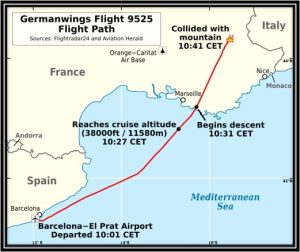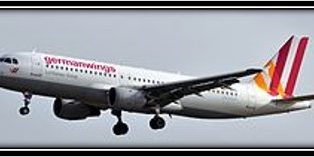On This Day in Aviation History-Germanwings Flight 9525
Contributor: Barry Fetzer
Sources: History.com, Wikipedia, Andrew Heneen, Flightrader24, Sebastien Mortier
If anything, what scares you about flying? Though I didn’t dwell on the possibilities too much when I was flying USMC aircraft, when I did think about it or when we discussed the subject in the ready room, consciously burning to death in a crashed aircraft was my #1 fear. Crashing into the water at night, having the aircraft roll over and sink with me descending helplessly into the dark as I struggled to extract myself from the doomed aircraft was probably my biggest #2 fear.
Flying commercially? I rarely, if ever, think about fears of flying with the pros. They get it right better than 99% of the time. But if I were to list my fear of flying on commercial aircraft, a crazed pilot taking his (or less likely, her) life along with all the passengers’ and crew’s lives would probably be my #1. It doesn’t, blessedly, happen that often, but it does happen as evidenced by the Germanwings crash in aviation history ten years ago today.
And highly secure cockpit hatches locked from the inside with no outside, emergency access possible, made necessary since the 911 hijackers changed air travel forever, make it even scarier. Even if you know there’s a nut case in the cockpit heading the aircraft and its passengers for sure death, there’s little to nothing we can do about it, evidenced by this day in aviation historical vignette and also by the 9-11 crash of UA Flight 93 that crashed into a field near Shanksville, Pennsylvania because passengers fighting back could not enter the cockpit soon enough (even with the, then, less secure cockpit hatch) to wrest control of the aircraft from the terrorists.
According to History.com editors and retrieved today from https://www.history.com/this-day-in-history/March-24/germanwings-pilot-intentionally-crashes-plane-killing-150-people, “On March 24, 2015, the co-pilot of a German airliner deliberately flies the plane into the French Alps, killing himself and the other 149 people onboard. When it crashed, Germanwings flight 9525 had been traveling from Barcelona, Spain, to Dusseldorf, Germany.

Photograph by Sebastien Mortier retrieved from Wikipedia. D-AIPX, the aircraft involved, pictured here in June 2014, less than a year before it was purposefully crashed into a mountain.
“The plane took off from Barcelona around 10 a.m. local time and reached its cruising altitude of 38,000 feet at 10:27 a.m. Shortly afterward, the captain, 34-year-old Patrick Sondenheimer, requested that the co-pilot, 27-year-old Andreas Lubitz, take over the controls while he left the cockpit, probably to use the bathroom. At 10:31 a.m. the plane began a rapid descent and 10 minutes later crashed in mountainous terrain near the town of Prads-Haute-Bleone in southern France. There were no survivors. Besides the two pilots, the doomed Airbus A320 was carrying four cabin crew members and 144 passengers from 18 different countries, including three Americans.

Map by Andrew Heneen – Own work based on: Flight path data from Flightradar24, specifically the page for D-AIPX. The data used for this map comes from the aircraft’s transponders, which does not involve any human creativity and is factual information (position & altitude of the aircraft). Nonetheless, Flightradar24 is credited as the source of the information.
“Following the crash, investigators determined once the captain had stepped out of the cockpit Lubitz locked the door and wouldn’t let him back in. Sondenheimer could be heard on the plane’s black box voice recorder frantically yelling at his co-pilot and trying to break down the cockpit door. (In the aftermath of 9/11, Lufthansa installed fortified cockpit doors; however, when the Germanwings flight crashed, the airline wasn’t required to have two crew members in the cockpit at all times, as U.S. carriers do.) Additionally, the flight data recorder showed Lubitz seemed to have rehearsed his suicide mission during an earlier flight that same day, when he repeatedly set the plane’s altitude dial to just 100 feet while the captain was briefly out of the cockpit. (Because Lubitz quickly reset the controls, his actions went unnoticed during the flight.)
“Crash investigators also learned Lubitz had a history of severe depression and in the days before the disaster had searched the Internet for ways to die by suicide as well as for information about cockpit-door security. In 2008, Lubitz, a German native who flew gliders as a teen, entered the pilot-training program for Lufthansa, which owns budget-airliner Germanwings. He took time off from the program in 2009 to undergo treatment for psychological problems but later was readmitted and obtained his commercial pilot’s license in 2012. He started working for Germanwings in 2013. Investigators turned up evidence that in the months leading up to the crash Lubitz had visited a series of doctors for an unknown condition. He reportedly had notes declaring him unfit to work but kept this information from Lufthansa.
“Instances of pilots using planes to die by suicide are rare. According to The New York Times, a U.S. Federal Aviation Administration study found that out of 2,758 aviation accidents documented by the FAA from 2003 to 2012, only eight were ruled suicides.”
Onward and upward!
Sources: History.com, Wikipedia, Andrew Heneen, Flightrader24, Sebastien Mortier







